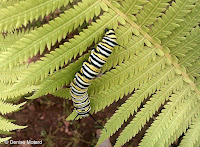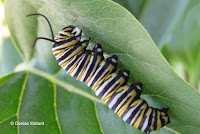CATERPILLAR
This page shows photos and videos taken of Monarch caterpillars raised inside, and of some observed outside in a garden. (General information on the Monarch butterfly can be found here.)
EGGS AND BABY CATERPILLARS (a separate page)
FEEDING
MOLTING (a separate page)
SEARCHING FOR A SPOT TO PUPATE
THE ‘J’ PHASE
TOO CLOSE FOR COMFORT
VARIATIONS IN COLOR PATTERNS
THE HANDICAPPED CATERPILLAR (a separate page)
FEEDING – Monarch caterpillars feed almost exclusively on Milkweed plants. (The word 'almost' is used because Monarch caterpillars also eat their egg shells and four molts for their nutrients.) Sometimes they will gnaw at the base of a flower stem (photo on the right) in order to partially detach it and let it hang down. This seems to make it easier for them to eat the flowers. They will also readily eat other parts of the milkweed plant, such as leaves and young seedpods.
 |
 |
 |
Here's a video of a Monarch caterpillar holding a flower with its legs while munching on it:
This video shows a Monarch caterpillar munching on a young seedpod:
SEARCHING FOR A SPOT TO PUPATE – When Monarch caterpillars are ready to pupate (turn into a chrysalis), they start looking for a suitable spot. Once they find it, they weave a silk pad and hang upside down from it in a ‘J’ position.
This stage lasts for around 10-12 hours. Apparently in the wild a Monarch caterpillar may crawl a distance up to 30 feet (10 meters) in order to find a suitable spot to pupate.
Usually however a caterpillar will take less than an hour to find a suitable spot, but there are individual differences (or preferences). Of the 35 caterpillars I raised so far, I had two particularly ‘restless’ ones that kept crawling for hours with no end in sight. (Their story is on this page: Monarch caterpillars with an attitude.)
The Monarch caterpillar shown below crawling down the swamp milkweed stems was observed the following day on the fern leaves nearby. It kept wandering for hours on the fern leaves, seemingly unable to find a suitable spot. After moving it into a nearby lilac, it quickly found a good spot, weaved its silk pad and turned into the ‘J’ phase (see its video below).
EXTENDING THEIR BODIES - When exploring around for a suitable spot to pupate, Monarch caterpillars can extend their bodies without support quite a bit :
 |
 |
 |
 |
Here's a video below of the same caterpillar weaving its silk pad, where the spinneret is visible:
THE ‘J’ PHASE - When the silk pad is ready, the caterpillar attaches itself to it from its last proleg pair, and slowly lets go of its four other pairs of prolegs, one by one starting with the pair closer to the true legs. The caterpillar then hangs upside down in a ‘J’ shape, a stage which lasts around 10-12 hours before it turns into a chrysalis.
The photo on the right shows the caterpillar sensors limp and twisted - they are emptied of any fluids. This indicates that the caterpillar will soon turn into a chrysalis.
 |
 |
 |
Here’s why it’s crucial for the Monarch caterpillar to attach itself securely to its silk pad, because it can be windy out there:
TOO CLOSE FOR COMFORT - Monarch caterpillars don’t appreciate being touched by another caterpillar, and will lunge at them. Yet they don’t show that reaction when we handle them.
Here’s another video of an ‘altercation’ between Monarch caterpillars:
VARIATIONS in color, and BELLY - Not all Monarch caterpillars are created equal in terms of color, as can be seen below. Some have more prominent black stripes and for others it’s the other way around, more prominent white stripes. As for their belly, the section in-between the legs and prolegs is greyish.
 |
 |
 |
This video below gives a good view of the Monarch caterpillar belly color: